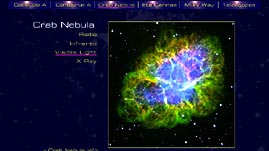Teachers' Domain - Digital Media for the Classroom and Professional Development
User: Preview

Source: Produced for Teachers' Domain
Telescopes are engineered to detect a specific range of wavelengths of electromagnetic radiation. Images from a variety of these telescopes show different aspects of the same astronomical objects. To trained eyes, each of the images in this collection produced for Teachers' Domain contributes details that provide a more comprehensive understanding of the observed object than is possible from a single image. Radio images highlight the presence of cooler gas clouds (especially hydrogen), infrared images show areas of low-energy heat, visible light images depict primarily gases and dust, and x-ray images reveal high-energy heat emissions.
Electromagnetic waves consist of oscillating electric and magnetic fields that radiate outward at the speed of light. The different types of electromagnetic radiation given off by the Sun, stars, and other astronomical objects are organized along a spectrum according to their wavelength, the distance between the peaks or troughs of successive waves.
Most of the universe is invisible to us because the human eye sees only the visible light portion of the electromagnetic spectrum. Infrared and radio emissions carry less energy per photon than visible light and thus have longer wavelengths and lower frequencies. Ultraviolet, x-ray, and gamma-ray emissions have shorter wavelengths and higher frequencies than visible light.
Images from telescopes engineered to detect different types of electromagnetic radiation show the same astronomical object in different ways. Skilled observers can recognize certain properties of the object from these images. For instance, in the case of a nebula, the gaseous remnant of an exploding star, the color and intensity of visible light and other portions of the spectrum indicate which elements are present and in what quantity. Infrared images provide information about planets, comets, newly forming stars, and other relatively cool bodies. X- ray telescopes capture and show radiation from very hot regions in stars and from violent events like explosions or collisions.
Because humans can only see the visible light portion of the spectrum, pictures that represent other types of radiation must present information about the radiation in the visual spectral range. This accounts for the "false" colors depicted in these images. The colors are arbitrary and are used only to enable us to see the variation and complexity of these images.
Some telescopes, including radio and optical telescopes, can detect astronomical objects from Earth. But because the water vapor, carbon dioxide, and oxygen in Earth's atmosphere absorb certain wavelengths of electromagnetic radiation, other telescopes -- including those that detect ultraviolet radiation and x rays -- must be in orbit to do their work.
By combining optical, radio, and infrared data from other telescopes with images from the Chandra X-ray Observatory, which produced some of the images in this collection, new details about far-off regions in space can be discerned. For example, some objects appear to have different shapes when viewed with different telescopes because the types of radiation the telescopes detect originate from matter in different places. Being able to make such composite interpretations has vastly increased our understanding of the past, present, and future of the universe.
To learn more about infrared telescope technology and just what can be learned from the images derived from it, check out Infrared Search for Origins.
To learn more about what you can discern from infrared images, including objects on Earth, check out Infrared: More Than Your Eyes Can See and Infrared Gallery.
To learn more about the electromagnetic spectrum, check out The Electromagnetic Spectrum: FRONTLINE.
To learn more about the electromagnetic spectrum in daily life, check out The Electromagnetic Spectrum: NASA.
 Loading Standards
Loading Standards Teachers' Domain is proud to be a Pathways portal to the National Science Digital Library.
Teachers' Domain is proud to be a Pathways portal to the National Science Digital Library.
